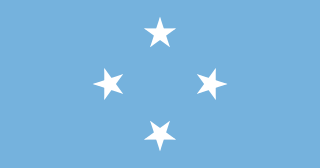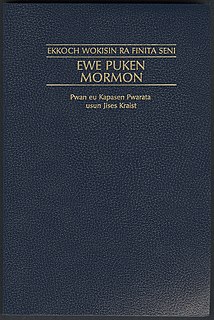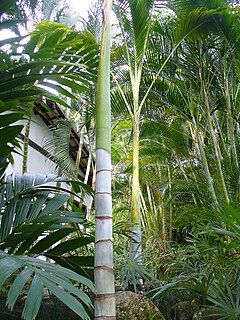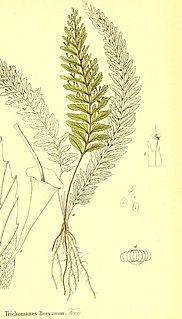A partial list of the some 250 islands of the Republic of Palau, located in the western Caroline Islands Archipelago. The islands are within the Micronesia region of Oceania, in the western Pacific Ocean.
A partial list of the some 250 islands of the Republic of Palau, located in the western Caroline Islands Archipelago. The islands are within the Micronesia region of Oceania, in the western Pacific Ocean.
| Name | Population | Area (square kilometer) | State |
| Angaur (Island) | 130 | 8.06 | Angaur (State) |
| Babeldaob (Island) | 5125 | 368 | Multiple states |
| Kayangel (Island) | 76 | 1.682 | Kayangel |
| Ngerekebesang Island | 1,778 | 2.44 | Koror |
| Oreor (Island) | 9800 | 9.3 | Koror |
| Peleliu (Island) | 500 | 18.5 | Peleliu (State) |
| Sonsorol (Island) | 42 | 3.1 | Sonsorol (State) |
| Tobi (Island) | 7 | 0.84 | Hatohobei |
| Malakal Island | 85 | 0.861 | Koror |
| Ngercheu | 20 | 1.098 | Peleliu (State) |
| Wikimedia Commons has media related to Islands of Palau . |

The Federated States of Micronesia, or simply Micronesia, is an island country in Oceania. It consists of four states – from west to east, Yap, Chuuk, Pohnpei and Kosrae – that are spread across the western Pacific. Together, the states comprise around 607 islands that cover a longitudinal distance of almost 2,700 km (1,678 mi) just north of the equator. They lie northeast of Indonesia and Papua New Guinea, south of Guam and the Marianas, west of Nauru and the Marshall Islands, east of Palau and the Philippines, about 2,900 km (1,802 mi) north of eastern Australia, 3,400 km (2,133 mi) southeast of Japan, and some 4,000 km (2,485 mi) southwest of the main islands of the Hawaiian Islands.

Geography of the Federated States of Micronesia (FSM), a country located in the western Pacific Ocean, and in the Micronesia cultural and ecological sub-region of Oceania. While its total land area is very small at 702 km2 (271 sq mi), it has the 14th largest exclusive economic zone at 2,996,419 km2 (1,156,924 sq mi).

Micronesia is a subregion of Oceania, consisting of about two thousand small islands in the western Pacific Ocean. It has a close shared cultural history with three other island regions: the Philippines to the west, Polynesia to the east, and Melanesia to the south—as well as with the wider community of Austronesian peoples.

The Caroline Islands are a widely scattered archipelago of tiny islands in the western Pacific Ocean, to the north of New Guinea. Politically, they are divided between the Federated States of Micronesia in the central and eastern parts of the group, and Palau at the extreme western end. Historically, this area was also called Nuevas Filipinas or New Philippines, because they were part of the Spanish East Indies and were governed from Manila in the Philippines.

The Mariana Islands are a crescent-shaped archipelago comprising the summits of fifteen mostly dormant volcanic mountains in the western North Pacific Ocean, between the 12th and 21st parallels north and along the 145th meridian east. They lie south-southeast of Japan, west-southwest of Hawaii, north of New Guinea and east of the Philippines, demarcating the Philippine Sea's eastern limit. They are found in the northern part of the western Oceanic sub-region of Micronesia, and are politically divided into two jurisdictions of the United States: the Commonwealth of the Northern Mariana Islands and, at the southern end of the chain, the territory of Guam. The islands were named after the influential Spanish queen Mariana of Austria following their colonization in the 17th century.

A lavalava, also known as an 'ie, short for 'ie lavalava, is an article of daily clothing traditionally worn by Polynesians and other Oceanic peoples. It consists of a single rectangular cloth worn similarly to a wraparound skirt or kilt. The term lavalava is both singular and plural in the Samoan language.

Geologically, a high island or volcanic island is an island of volcanic origin. The term can be used to distinguish such islands from low islands, which are formed from sedimentation or the uplifting of coral reefs.

The Catholic Diocese of Caroline Islands is an ecclesiastical territory or diocese of the Catholic Church in the Federated States of Micronesia and in the Republic of Palau. It is a suffragan diocese of the Ecclesiastical Province of Agaña. The Diocese of Caroline Islands is led by a bishop who pastors the mother church, the Cathedral of the Immaculate Heart of Mary.

Pohnpei State is one of the four states of the Federated States of Micronesia (FSM). The other states are, from east to west, Kosrae State, Chuuk State, and Yap State. The state's main island is Pohnpei.

Chuuk State is one of the four states of the Federated States of Micronesia (FSM). The other states are Kosrae State, Pohnpei State, and Yap State. It consists of several island groups:

Chuukese, also rendered Trukese, is a Chuukic language of the Austronesian language family spoken primarily on the islands of Chuuk in the Caroline Islands in Micronesia. There are communities of speakers on Pohnpei, Guam, and the Hawaiian Islands as well. Estimates show that there are about 45,900 speakers in Micronesia.
Western Islands may refer to the:
Mokilese also known as Mwoakilloan, Mwokilese, or Mwoakilese is a Micronesian language originally spoken on Mwoakilloa, Federated States of Micronesia. Of the 1200 Mokilese speakers, only about 500 live on Mwoakilloa.

Clinostigma is a genus of flowering plant in the Arecaceae (palm) family, native to various islands in the western Pacific. It contains the following species:

The population of the Federated States of Micronesia is predominantly Christian, although the representation of various denominations varies greatly from state to state. The government generally upholds the freedom of religion, but the small Muslim community in the country faces significant discrimination from both general society and the government.

The Solomon Islands is an archipelago in the western South Pacific Ocean, located northeast of Australia. The archipelago is in the Melanesia subregion and bioregion of Oceania. It forms the eastern boundary of the Solomon Sea. The archipelago forms much of the territory of Solomon Islands. The main islands are Choiseul, the Shortland Islands, the New Georgia Islands, Santa Isabel, the Russell Islands, the Florida Islands, Tulagi, Malaita, Maramasike, Ulawa, Owaraha, Makira, and Guadalcanal. The largest island, Bougainville Island, is geographically part of the Solomon Islands (archipelago), while politically an autonomous region of Papua New Guinea. The nation state of Solomon Islands covers a subset of the Solomon Islands archipelago and includes isolated low-lying coral atolls and high islands including Sikaiana, Rennell Island, Bellona Island, and the Santa Cruz Islands.
Carolines may refer to:

Cephalomanes atrovirens is a species of fern in the family Hymenophyllaceae. The genus Cephalomanes is accepted in the Pteridophyte Phylogeny Group classification of 2016, but not by some other sources. As of October 2019, Plants of the World Online sank the genus into a broadly defined Trichomanes, while treating the subtaxa of this species as the separate species Trichomanes acrosorum, Trichomanes atrovirens, Trichomanes boryanum and Trichomanes kingii.